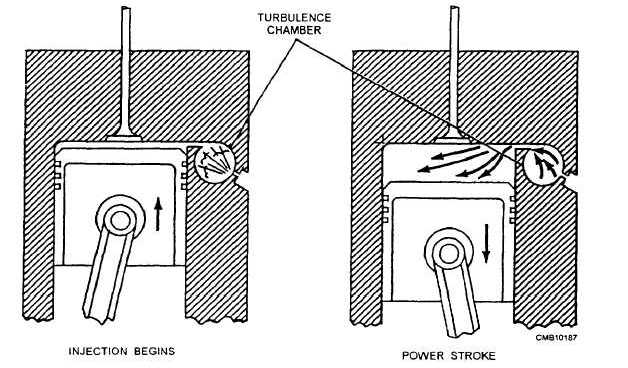causes turbulence in the main combustion chamber, as the fuel enters from the precombustion chamber to aid in mixing with air. The following steps occur during the precombustion process:
During the compression stroke of the engine, air is forced into the precombustion chamber and, because the air is compressed, it is hot. At the beginning of injection, the precombustion chamber contains a definite volume of air.
As the injection begins, combustion begins in the precombustion chamber. The burning of the fuel, combined with the restricted passage to the main combustion chamber, creates a tremendous amount of pressure in the combustion chamber. The pressure and the initial combustion cause a super-heated fuel charge to enter the main combustion chamber at a high velocity.
The entering mixture hits the hollowed-out piston top, creating turbulence in the chamber to ensure complete mixing of the fuel charge with the air. This mixing ensures even and complete combustion. This chamber design provides satisfactory performance with low fuel injection pressures and coarse spray patterns because a large amount of vaporization occurs in the precombustion chamber. This chamber also is not very susceptible to ignition lag, making it suitable for high-speed operations.
Turbulence Chamber
The turbulence chamber (fig. 54) is similar in appearance to the precombustion chamber, but its function is different. There is very little clearance between the top of the piston and the head, so a high percentage of the air between the piston and cylinder head is forced into the turbulence chamber during the compression stroke. The chamber is usually spherical, and the small opening through which the air must pass causes an increase in air velocity, as it enters the chamber. This turbulence speed is about 50 times crankshaft speed. The fuel injection is timed to occur when the turbulence in the chamber is greatest. This ensures a thorough mixing of the fuel and air, causing the greater part of combustion to take place in the turbulence chamber. The pressure, created by the expansion of the burning gases, is the force that drives the piston downward on the power stroke.
Spherical (Hypercycle) Chamber
The spherical (hypercycle) combustion chamber (fig. 5-5) is designed principally for use in the multifuel diesel engine. The chamber consists of a basic open type chamber with a spherical shaped relief in the top of the piston head. The chamber works in conjunction with a strategically positioned injector and an intake port that produces a swirling effect, as it enters the chamber. Operation of the chamber is as follows:

Figure 5-4. - Turbulence chamber.
Continue Reading